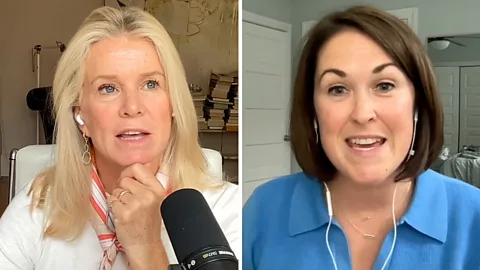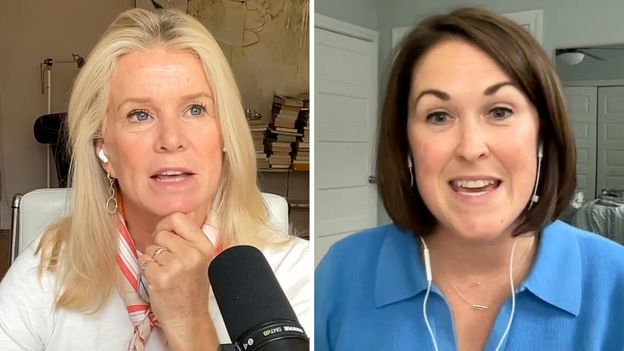Successful women are quitting their jobs. Why?

 BBC
BBCThe latest jobs data from the United States government shows that between January and July 2025, 212,000 women left the workforce at the same time that 44,000 men entered it.
As with all economic data, there’s likely more than one reason why the trendlines of women quitting and men being hired are diverging. The data caught my eye because it comes at a time when increasing numbers of women in high-performing, white-collar jobs report that they’re reconsidering their relationships to their careers.
In a recent piece for the New York Times, writer Issie Lapowsky unpacked what some are calling “the power pause”. After years of leaning in and pursuing career growth, an emerging slice of college-educated women are either going part time or quitting their jobs entirely.
Choosing not to work is obviously a decision that is not financially viable for many (if not most) people. And while more data is needed to show just how substantive this trend is, it aligns with what numerous surveys have shown in recent years: the number of women thinking about leaving their job or reducing their hours has grown since Covid-19.
I called up Issie to ask her more about what many of these women have told her about why they’re leaving work – and what impact this trend may have on women’s advancement in the workplace.
You can watch or read more of our conversation below.
Below is an excerpt from our conversation, which has been edited for length and clarity.
Katty Kay: You’ve spoken to women who were thriving professionally, but still made the decision to step away. What did you hear from them about why they were making that decision and why now?
Issie Lapowsky: This was a story about a very specific subgenre of women deciding to step away. These were women who were making an affirmative choice for themselves, who had reached a certain level of success in their careers and looked around and said, “I want to step away to spend time with my child. I want to step away to be my own boss. I want to step away to do something completely different.” These were women who were making very conscious choices for themselves – and I think bucking the narrative that when women leave the workforce, it is always something that happens to them.
There are so many other stories that could be told of women who have no choice, who either cannot afford childcare or are among the many layoffs that disproportionately impact women. This was not one of those stories.
KK: When I started researching the issue of women in business back in 2008, I remember coming across a study showing that in some fields more professional women were leaving the workforce than there were joining it for the first time in American history. When I read your piece, part of me kind of thought, “Here we go again.”
Do your findings just suggest that, however long it takes, society can’t get this right? I hate the phrase “work life balance”, but that we just can’t figure out how to allow professional women to work and have children at the same time in a way that is satisfying and harmonious for everybody?
IL: I think there’s absolutely something to that, but for a lot of these women, it wasn’t that they felt they couldn’t make it work. I spoke with one woman who said, “If there is such a thing as having it all, I had it.” I spoke with another woman who had the means to hire nannies, and people would say, “Just get another nanny,” and it will always stick with me that she said, “I don’t want another nanny. I want my moments.”
There is no work-life balance that is going to give you all of your time with your kids, if that’s what you want. And some of these women in my story are not mothers. They were leaving the workforce for other priorities.
KK: Why do you think this trend is happening at this moment?
IL: I really wanted this piece to interrogate how the pandemic played into these trends. I experienced this myself as a new mom at the start of the pandemic. My husband and I were both full-time working parents, we had no childcare. I was writing as a business reporter about the high numbers of women who were being forced out of the workforce, millions of them.
And I thought to myself: “Here I am with my kid in the other room and I really like it.” As somebody who had never considered stepping back from work, I could imagine spending all of my time doing this. So, as a purely data-driven question, I wondered how many women in those millions of women being “forced out” were actually making a conscious choice, because they suddenly were in a position where they were being exposed to what life might be like being home with their kids.
What’s been interesting is that the data bore that out. There has been an uptick since the pandemic in women identifying as stay-at-home moms – many of them say they have done so because they wanted to spend time with their children and not, for instance, because they couldn’t afford the cost of childcare. There was an uptick in the number of women identifying as working part time from home post pandemic. The numbers of female leaders – mothers and non-mothers – were leaving their companies at record rates, according to a McKinsey and LeanIn Study.
So, all of this post-pandemic data was bearing out the idea that all of the flexibility, the remote work, people moving away, having more time with their kids, all of it kind of came together in this stew to have all of us – and especially women – recalibrating our priorities.
KK: Did any of the women you spoke to feel complicated about it, given this moment that we’re in where we’re hearing more about the tradwife aesthetic and where there’s a push against diversity initiatives? Did any of them feel that while this was personally the right time for them to step away, that for women writ large, being on the front lines of the work struggle was actually the place they were needed?
IL: Yes, I would say this was a complicated decision for all of these women. They all wrestled with exactly that. I think particularly women of colour. What they had to wrestle with was how much of my life and my happiness do I sacrifice for this larger cause to which I have contributed for many years – versus how much do I get to enjoy the fruits of my labour.
KK: Did any of them worry about whether it would be possible for them to step back into their careers again, if they wanted to?
IL: Yes, I think all of these women worried about, “What happens to my career long term? I might want to do this for a few years but do I want to do it forever?” That’s where the storytelling element really comes in. You’re seeing all of these confessionals on LinkedIn of women putting their own stamp on this decision and saying, “This is a move I’m making,” and not, “Oh, I’m just not working.”
KK: This is what you’ve referred to as “The Power Pause”.
IL: Exactly. That term was coined by a woman named Neha Ruch, who wrote a book of the same name. It’s this idea that if society were to accept that this can be a period of growth for women, that this is not them being a victim, that this is a move that they’re making like any other career or personal move, then we can accept them back into the workforce in a way that like honours that. If we can identify that in this period, you’re not in the workforce but you are still growing and learning skills – you’re the manager of your household and all these other things – then we can get women back in more easily.
KK: Did you come away from the research on this piece feeling optimistic or pessimistic about the position of women in the workforce?
IL: It’s such a nuanced topic. I was optimistic about the fact that women were feeling empowered in these decisions. These were moves born of optimism. But whether I feel optimistic? There are still so many challenges that women face in general at work and in raising and affording families.
I think I walked away with a nuanced feeling. You have to hold these two things concurrently: yes, a certain group of women who have means, education and often have support are making these decisions – and that’s great. That’s empowering. At the same time, you have growing numbers of women who have no other choice.
—
If you liked this story, sign up for The Essential List newsletter – a handpicked selection of features, videos and can’t-miss news, delivered to your inbox twice a week.











